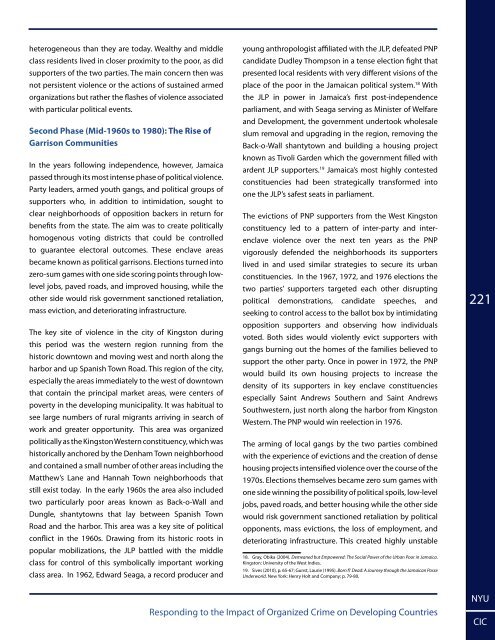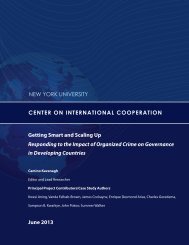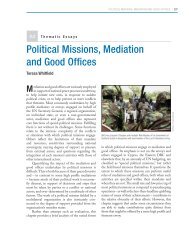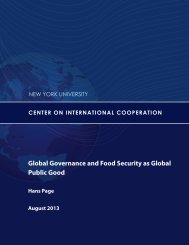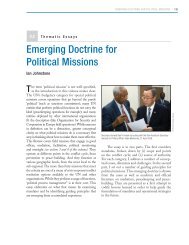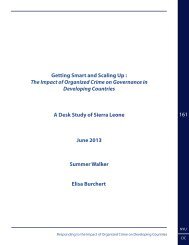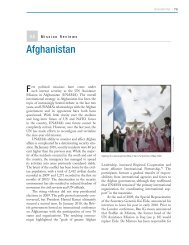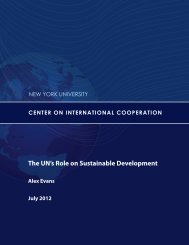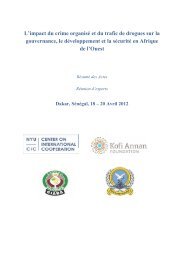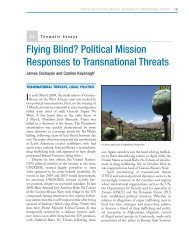Jamaica - Center on International Cooperation
Jamaica - Center on International Cooperation
Jamaica - Center on International Cooperation
You also want an ePaper? Increase the reach of your titles
YUMPU automatically turns print PDFs into web optimized ePapers that Google loves.
heterogeneous than they are today. Wealthy and middle<br />
class residents lived in closer proximity to the poor, as did<br />
supporters of the two parties. The main c<strong>on</strong>cern then was<br />
not persistent violence or the acti<strong>on</strong>s of sustained armed<br />
organizati<strong>on</strong>s but rather the flashes of violence associated<br />
with particular political events.<br />
Sec<strong>on</strong>d Phase (Mid-1960s to 1980): The Rise of<br />
Garris<strong>on</strong> Communities<br />
In the years following independence, however, <str<strong>on</strong>g>Jamaica</str<strong>on</strong>g><br />
passed through its most intense phase of political violence.<br />
Party leaders, armed youth gangs, and political groups of<br />
supporters who, in additi<strong>on</strong> to intimidati<strong>on</strong>, sought to<br />
clear neighborhoods of oppositi<strong>on</strong> backers in return for<br />
benefits from the state. The aim was to create politically<br />
homogenous voting districts that could be c<strong>on</strong>trolled<br />
to guarantee electoral outcomes. These enclave areas<br />
became known as political garris<strong>on</strong>s. Electi<strong>on</strong>s turned into<br />
zero-sum games with <strong>on</strong>e side scoring points through lowlevel<br />
jobs, paved roads, and improved housing, while the<br />
other side would risk government sancti<strong>on</strong>ed retaliati<strong>on</strong>,<br />
mass evicti<strong>on</strong>, and deteriorating infrastructure.<br />
The key site of violence in the city of Kingst<strong>on</strong> during<br />
this period was the western regi<strong>on</strong> running from the<br />
historic downtown and moving west and north al<strong>on</strong>g the<br />
harbor and up Spanish Town Road. This regi<strong>on</strong> of the city,<br />
especially the areas immediately to the west of downtown<br />
that c<strong>on</strong>tain the principal market areas, were centers of<br />
poverty in the developing municipality. It was habitual to<br />
see large numbers of rural migrants arriving in search of<br />
work and greater opportunity. This area was organized<br />
politically as the Kingst<strong>on</strong> Western c<strong>on</strong>stituency, which was<br />
historically anchored by the Denham Town neighborhood<br />
and c<strong>on</strong>tained a small number of other areas including the<br />
Matthew’s Lane and Hannah Town neighborhoods that<br />
still exist today. In the early 1960s the area also included<br />
two particularly poor areas known as Back-o-Wall and<br />
Dungle, shantytowns that lay between Spanish Town<br />
Road and the harbor. This area was a key site of political<br />
c<strong>on</strong>flict in the 1960s. Drawing from its historic roots in<br />
popular mobilizati<strong>on</strong>s, the JLP battled with the middle<br />
class for c<strong>on</strong>trol of this symbolically important working<br />
class area. In 1962, Edward Seaga, a record producer and<br />
young anthropologist affiliated with the JLP, defeated PNP<br />
candidate Dudley Thomps<strong>on</strong> in a tense electi<strong>on</strong> fight that<br />
presented local residents with very different visi<strong>on</strong>s of the<br />
place of the poor in the <str<strong>on</strong>g>Jamaica</str<strong>on</strong>g>n political system. 18 With<br />
the JLP in power in <str<strong>on</strong>g>Jamaica</str<strong>on</strong>g>’s first post-independence<br />
parliament, and with Seaga serving as Minister of Welfare<br />
and Development, the government undertook wholesale<br />
slum removal and upgrading in the regi<strong>on</strong>, removing the<br />
Back-o-Wall shantytown and building a housing project<br />
known as Tivoli Garden which the government filled with<br />
ardent JLP supporters. 19 <str<strong>on</strong>g>Jamaica</str<strong>on</strong>g>’s most highly c<strong>on</strong>tested<br />
c<strong>on</strong>stituencies had been strategically transformed into<br />
<strong>on</strong>e the JLP’s safest seats in parliament.<br />
The evicti<strong>on</strong>s of PNP supporters from the West Kingst<strong>on</strong><br />
c<strong>on</strong>stituency led to a pattern of inter-party and interenclave<br />
violence over the next ten years as the PNP<br />
vigorously defended the neighborhoods its supporters<br />
lived in and used similar strategies to secure its urban<br />
c<strong>on</strong>stituencies. In the 1967, 1972, and 1976 electi<strong>on</strong>s the<br />
two parties’ supporters targeted each other disrupting<br />
political dem<strong>on</strong>strati<strong>on</strong>s, candidate speeches, and<br />
seeking to c<strong>on</strong>trol access to the ballot box by intimidating<br />
oppositi<strong>on</strong> supporters and observing how individuals<br />
voted. Both sides would violently evict supporters with<br />
gangs burning out the homes of the families believed to<br />
support the other party. Once in power in 1972, the PNP<br />
would build its own housing projects to increase the<br />
density of its supporters in key enclave c<strong>on</strong>stituencies<br />
especially Saint Andrews Southern and Saint Andrews<br />
Southwestern, just north al<strong>on</strong>g the harbor from Kingst<strong>on</strong><br />
Western. The PNP would win reelecti<strong>on</strong> in 1976.<br />
The arming of local gangs by the two parties combined<br />
with the experience of evicti<strong>on</strong>s and the creati<strong>on</strong> of dense<br />
housing projects intensified violence over the course of the<br />
1970s. Electi<strong>on</strong>s themselves became zero sum games with<br />
<strong>on</strong>e side winning the possibility of political spoils, low-level<br />
jobs, paved roads, and better housing while the other side<br />
would risk government sancti<strong>on</strong>ed retaliati<strong>on</strong> by political<br />
opp<strong>on</strong>ents, mass evicti<strong>on</strong>s, the loss of employment, and<br />
deteriorating infrastructure. This created highly unstable<br />
18. Gray, Obika (2004). Demeaned but Empowered: The Social Power of the Urban Poor in <str<strong>on</strong>g>Jamaica</str<strong>on</strong>g>.<br />
Kingst<strong>on</strong>: University of the West Indies.<br />
19. Sives (2010), p. 65-67; Gunst, Laurie (1995). Born fi’ Dead: A Journey through the <str<strong>on</strong>g>Jamaica</str<strong>on</strong>g>n Posse<br />
Underworld. New York: Henry Holt and Company; p. 79-80.<br />
221<br />
Resp<strong>on</strong>ding to the Impact of Organized Crime <strong>on</strong> Developing Countries<br />
NYU<br />
CIC


